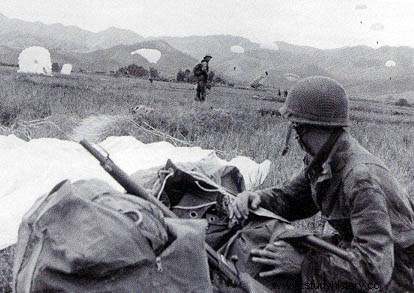
The large number of initial successes achieved by airborne forces in Indochina had persuaded the French in 1953 that the Viet Minh could be forced to fight following the placement by air of a "bait" in an area it needed, and that it could then be destroyed by a battle of attrition. On the contrary, the Battle of Diên Biên Phû sounded the death knell for French colonial ambitions.
If military history were to be taught by word associations, the first name following "French Indochina" would be " Diên-Biên Phû” and the first idea that would come next would be “disastrous defeat”. Fortunately we do not practice this kind of teaching, but many people persist in believing that the operations of the French in Indochina, and particularly their airborne actions, were only a series of blunders.
The First Indochina War began in 1946 when, after a year of negotiations between Vietnamese nationalist leader Ho Chi Minh and the French, a French convoy was ambushed and destroyed in August at Bac Ninh. At that time, Vô Nguyên Giap, military expert of Hô, had under his command about 50,000 men with a heterogeneous armament of Japanese, American and French origin. He had so far failed to get help from the communist bloc, and China had yet to extricate itself from its civil war. We knew that the Viet Minh had waged guerrilla warfare against the Japanese occupation forces since 1941, and we can recall, not without irony, that he had received support from the United States during the war
Isandlwana was one of the hardest blows to the forces of 19th century imperialism; the events that took place there reminded the colonial powers not to underestimate the capacities of the indigenous opposition. Initially intimidated by the firepower of the British, the Zulu warriors crushed the Engl
